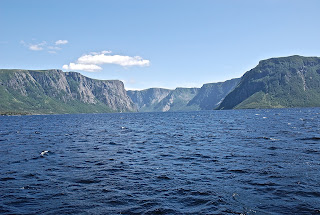While the scenery is
spectacular, our enduring memories will be about the people. Our experiences
tell us that Newfoundlanders, young and old alike, are friendly outgoing
people. They always find time to talk to strangers. Their way of life seems
slower than in many other parts of Canada. Driving through villages, we often
saw people stopping to visit with neighbors along the road. Sadly, the
conversations were often between young and middle-aged men between 9:00 am and
5:00 pm; obviously, they are unemployed and had unwelcome time on their hands.
It was rare that we would meet people in villages and not be greeted with a
friendly hello or good morning, even in the most casual circumstances. In
St. John’s people on the street nod hello. Typical of the helpful people we
encountered, an employee at the Sheraton Hotel gave us detailed explanations,
plus personal reflections about visiting the Quidi Vidi Brewery, including
coming outside the hotel to be sure we knew where the brown fence where we
would make a right turn was located.
Newfoundlanders are
humorous people. Perhaps, because of the hard times they have faced, they have
learned to use humor as a way of dealing with difficulties. They are especially
irreverent about politicians; having been let down so often, they have a
healthy skepticism about promises from their leaders. Poor Kathy Dunderdale is
affectionately referred to as Kathy Dunderhead.
There is no doubt that
Newfoundlanders have some unique expressions, unknown to other Canadians. Much
scholarly work has been devoted to the so-called Newfie accent. It is more than
an accent; it has its origins in the history of the people who settled the
island: English, French, Portuguese, Irish and so on. Newfoundlanders claim to
be able to spot where a person grew up by the way he or she talks, particularly
by the expressions that are used.
Much of Newfoundlanders’
daily speech blissfully breaks rules of grammar and accepted English usage:
verbs often do not agree with subjects (“I is goin’ to git dat right now.”),
youse replaces you, dat for that, tree for three---the list is long. B’y
(pronounced bye) is an all purpose word of acknowledgement without gender: “Well
b’y, how is youse today?” “Love” and “darling” are often used indiscriminately:
“Well, darling, what can I get youse to drink?” Although we never had it
applied to us, ducky is often used as a term of endearment, even for total strangers:
“Until then, my ducky.” The greeting, “Whaddya at?” translates as “How are
you?” We heard an unusual usage at the hotel dining room just before we
departed. The server, after we had eaten our meal, inquired, “How was the
scallops after?” Where the “after” came from is a mystery. The language differences in the final analysis do not matter at all. Effective communication is always the goal--and there was never any difficulty communicating with the friendly people of Newfoundland!
There is much evidence throughout
the province of the benefits from oil money. We met many people who have family
members working “away,” especially at Fort McMurray. The money shows up in
large, new houses—even in small fishing villages. Half-ton trucks are often
parked in front of the new houses. Apparently, house prices in St. John’s have
skyrocketed.
Everywhere, people are
trying to cope with change. There are still major repercussions from the
disastrous 1992 Cod Moratorium that put 30,000 people permanently out of work
in one fell swoop and made the name of John Crosbie infamous. Unemployment is
chronically high. The island’s population has only recently seen a modest
increase after decades of slow decline. The increase is due to oil wealth,
including the Hibernia off shore site and, of course, oil sands money. Also,
former Premier Danny Williams instituted a $1,000 grant to parents for each
child that is born in the province, jokingly called Danny Bucks.
The difficulty of dealing
with change was forcefully brought home to us in Little Bay Islands as the
people are dealing with an uncertain future. Almost certainly, the government
offer of $250,000 per household will be accepted; and the villagers, including
seniors who have never lived any other place in their lives, will move. Without
ferry service, electricity, water and sewer, etc. life will be
unsustainable. The money does nothing to
lessen the anxiety, however. Al Pittman, well respected in the province, has
written poems and plays about the heartbreak of resettlement:
So the government paid us for
movin’ away,
And leaving our birthplace for a
better day’s pay;
They said that our poor lives would
ne’er be the same,
Once we took part in the government
game….
(From
“The Government Game” by Newfoundland poet Al Pittman)





















































